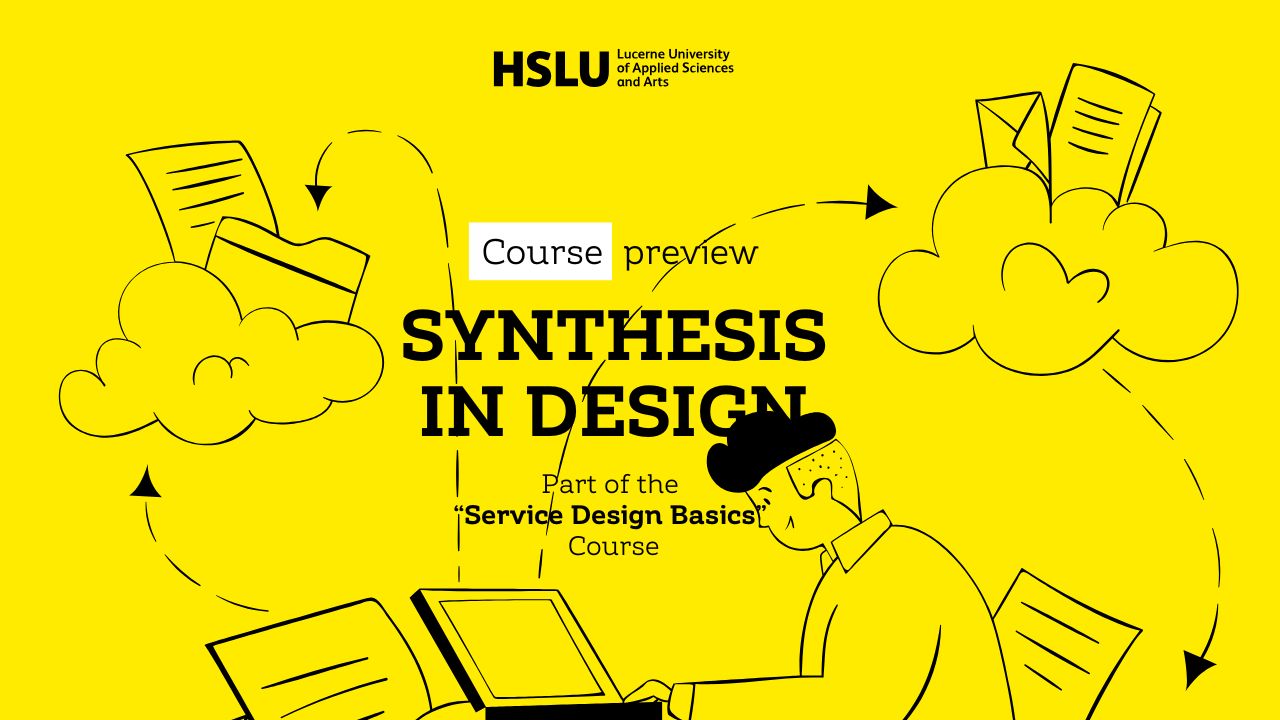That’s the question that the first-year Service Design practitioners of the Master Service Design of the HSLU, Lucerne University of Applied Sciences and Arts, explored today. This exploration is part of the series on « Service Design Basics ».
To do this, the students followed a « Learning by teaching » approach: shared learnings from reading material, shared personal tips from experience and practice, and all of it through practical exercises following the following questions:
- What are Synthesis and Insights?
- What are tools that can help me do a Synthesis?
- How can I use a Service Blueprint for Synthesis?
Below you’ll find all the details about this approach, you will get access to the reading material used, and even get the slide decks that the learners created for their « learning by teaching » moments.
The slide deck used
You can see below the slide deck that was used this day of learning by teaching.
What are Synthesis and Insights?
Learning by teaching
One group of Service Design practitioners explored the question « What are Synthesis and Insights? ». Here is the presentation they shared after synthesising what they learned from the reading material:
The reading material
Here you’ll find links to the reading material that the group used to prepare this session:
- Presentation: Jon Kolko – Methods of Design Synthesis
- Video: TEDxCreativeCoast – Jon Kolko – The Phenomenon of Synthesis
- Article: Data vs. Findings vs. Insights: The Differences Explained
- Video: Data vs. Findings vs. Insights
- Article: Design Analysis & Synthesis: A Palette Of Approaches by John Payne
- Q&A: What are different types of research insights?
Personal tips
Here are a few additional tips that the Service Design practitioners following in the class shared on this topic:
- Start early
- Do summaries during and right after the interviews
- Boomark key elements of a conversation whil recording it.
- Use inspiration from the scientific method
- Set a hypothesis and verify it in the data you gathered
- Explore diverse sources of data
- Do line-by-line coding of the interview
- Listen to your guts
- Look for the strong emotional pieces of data instead of the average
- Rules of thumb
- If you can’t draw it, maybe you didn’t understand it yet.
- Making it visual clarifies what you understand
What are tools that can help me do a Synthesis?
Learning by teaching
One group of Service Design practitioners explored the question « What are tools that can help me do a Synthesis? ». Here is the presentation they shared after synthesising what they learned from the reading material:
The reading material
Here you’ll find links to the reading material that the group used to prepare this session:
- Q&A: What’s a good structure for a research report?
- Q&A: How can I visualise complex ideas with simple forms?
- Article: Information Architecture: Synthesis Techniques for the Muddy Middle of the Design Process
- Presentation: Jon Kolko – Methods of Design Synthesis
Personal tips
Here are a few additional tips that the Service Design practitioners following in the class shared on this topic:
- Use technology to get first drafts
- Use generative AI tools to categorize parts of interviews and find themes
- Use local AI tools like jan.io for better data privacy
- Tools for visual synthesis
- Visual collage
- Internet Memes format
- Use metaphors
- Remix, mashup existing visual metaphors
- Canva has a lot of base material to play with
- Use the tool you are comfortable with
- Visuals help summarise
- Visualizing helps me to select the most important thing to say
- It’s easier to summarise with visuals than with words.
- Qualities of visual synthesis
- Visuals are a great way to show where I am and what I see
- Visualising makes the biases clearer
- Visualising can help you change perspective
- Visualising shows well the hierarchies that exist in a system
How can I use a Service Blueprint for Synthesis?
Learning by teaching
One group of Service Design practitioners explored the question « How can I use a Service Blueprint for Synthesis? ». Here is the presentation they shared after synthesising what they learned from the reading material:
The reading material
Here you’ll find links to the reading material that the group used to prepare this session:
- Book: Your Guide to Blueprinting the Practical Way!
- Q&A: What are the different types of Service Blueprints?
- Q&A: What are some common mistakes to avoid when you create a Service Blueprint?
- Q&A: What are good tools to create a service blueprint?
Personal tips
Here are a few additional tips that the Service Design practitioners following in the class shared on this topic:
- How to approach a Service Blueprint
- Start with a complex blueprint then simplify
- Service Blueprints can look very different and very creative
- Don’t take it too seriously
- Qualities observed in your blueprints
- The visual transmits the emotion (making it messy gives the emotion of it’s messy)
- Including time spent or waited
- Choosing a focus for the Blueprint
- A suggestion block with early ideas.
Why we are sharing these resources
We’re sharing all the resources that we used to run this one-day workshop so that it can:
- Help future students: by getting a sense of what happens in the program before joining it.
- Help other educators: by sharing how in-the-behind-the-scenes such workshops are designed and inspire them for their own approach in teaching Service Design
Licence
The original content shared here is licensed under CC BY-NC-SA 4.0. This means you’re allowed to:
- Share it, adapt it, and make it your own
- As long as you mention the original authors, share it under the same license, and don’t use it in a commercial setting



